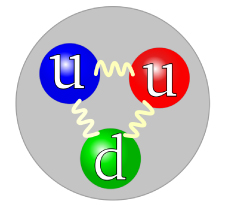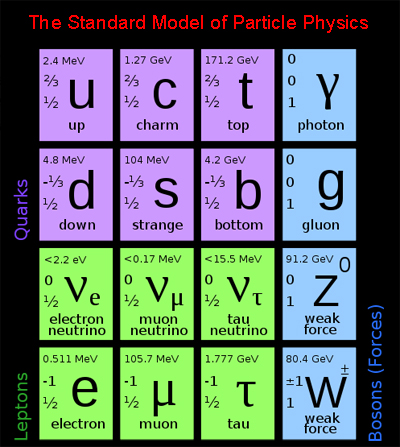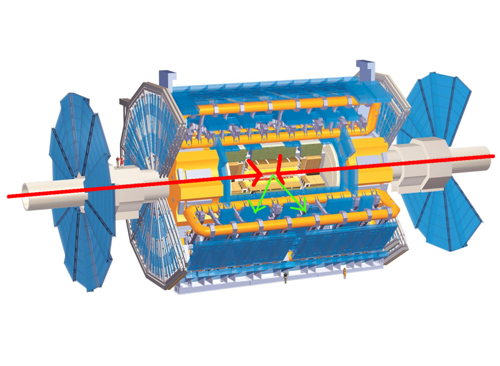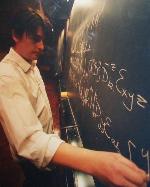
Particle hunting at the LHC

A diagrammatic view of the LHC. Image © CERN.
It's hard to avoid CERN these days. Last year's successful switch-on of CERN's Large Hadron Collider, followed by a blow-out which is currently being fixed, sparked wide-spread media coverage, and currently CERN stars in the Tom Hanks movie Angels and Demons. So what goes on at CERN and why the hubbub about the Large Hadron Collider, known as the LHC?
CERN is the European Centre for Particle Physics and the LHC is the world's largest laboratory experiment. It's a particle accelerator sitting about 100m below the Earth's surface, in a huge tunnel on the Franco-Swiss border. When the repairs are completed by the end of 2009, the experiment will be smashing together tiny particles of matter in the hope of finding answers to some deep questions about the way our Universe works.
How tiny are the particles?

Electrons orbiting the nucleus of a carbon atom. Image courtesy NASA.
Consider an atom of carbon, one of the most ubiquitous elements on Earth. It's about a tenth of a billionth of a metre across, about one millionth of the breath of a human hair. This atom is mostly space — some particles, electrons, are zipping around the edge, but in the middle lies a hard centre, the carbon nucleus, which is about one ten-thousandth the size of the whole atom. If we picked apart the nucleus, we'd find that it is made of twelve particles stuck together. Of these, six have a positive electric charge, they are called protons, while the other six are neutrons, which have no electric charge. Protons measure roughly a thousandth of a billionth of a millimetre across. It is these tiny particles that the Large Hadron Collider will be smashing together to within a cat's whisker of the speed of light.
The standard model of particle physics
The fragments of these collisions will give physicists hotly sought-after information about the tiniest constituents of matter, the fundamental particles. Protons are prime candidates for this experiment because of their electric charge: it's needed to accelerate the particles, so charge-less neutrons wouldn't do, and unlike electrons, which lose a lot of energy by x-ray emission, protons lose less energy as they are being accelerated.
So far, smashing bits of matter together has helped physicists to compile a list of twelve fundamental particles that seem to make up the everyday matter that we see around us. The list includes electrons, but also particles called quarks, which make up protons, and which are held together by a sticky force called the strong nuclear force. There are other fundamental particles too, known as leptons and bosons. Besides the strong nuclear force and the familiar forces of gravity and electromagnetism, there is one more fundamental force, the weak nuclear force, which causes radioactive decay. The physical description of the fundamental particles, together with a mathematical description of how they behave, is known as the standard model of particle physics.

Protons are made up of quarks. Image courtesy Arpad Horvath.
It turns out that when matter particles "feel a force", what is really happening on small distances is that particles are bumping in to each other. The electrostatic repulsive force between two electrons for instance, arises because one electron emits a photon, which then bumps into the other electron. Through conservation of momentum, this makes them fly apart a little. If we take into account that this process happens many times per second, then it appears as if the electrons feel the smooth form of repulsion that is familiar from physics in school. The standard model describes all known forces except gravity (which remains something of a mystery) in terms of the exchange of such particles. Particles of light, photons, carry electric and magnetic fields. The strong nuclear force in protons operates by exchanging particles called gluons.
The standard model, which was developed in the early 1970s, describes experiments with tremendous precision, in hundreds of different situations. But despite the amazing experimental success, there is a potentially fatal flaw in the theory: physicists have known for a long time that some fundamental particles have mass, but the mathematics underlying the standard model predicts that they should be massless. This false prediction is more than a minor error that's easily corrected: without the zero mass assumption the model just wouldn't work. A theoretical resolution to this puzzle came from a mechanism proposed in the 1960s by the physicist Peter Higgs (and others). But to understand his theory, we first have to understand what exactly we mean by a particle.
Electron Jelly
It is easy to be lulled into thinking of a particle as a tiny billiard ball. But delving into quantum theory, we find that things are much more interesting: it appears that the billiard ball picture is only an approximation of reality. Electrons, for example (though the example applies to all of the other particles in the standard model as well), are better thought of as a weird sort of quantum jelly, which fills space. Like any liquid, the jelly can be calm like the surface of an undisturbed lake, or it can ripple. In the parts of space where the jelly is calm, we measure a vacuum. But where there a ripples in the jelly, we measure an electron. There is only one electron jelly, and it fills the Universe. It contains ripples in countless different places, and in each ripple, we could measure an electron. What's more, ripples in the electron jelly tend to produce ripples in the photon jelly, and vice versa. Thus, moving electrons tend to "produce photons". On the other hand, photon jelly ripples can effect electron jelly ripples and so electrons "feel" the force of the photons. This is the electromagnetic force (i.e. the photon jelly) acting on the electrons. Of course the jelly is only an analogy: there is a precise mathematical theory that describes it, and which talks about quantum fields instead of jelly.
The Higgs Boson

The fundamental particles of the standard model. Image MissMJ.
Higgs resolved the mass conundrum by considering the Universe right after the Big Bang, when it was hot and dense. He conjectured that at this early time all particle jellies were runny, just like water. But as the Universe cooled down, one particular jelly, known as the Higgs field started to condense and become more viscous. Other particles (or particle jellies), when interacting with the Higgs field, are dragged back, just as a person walking through custard would be. Particles which experience this drag effect are experiencing inertia — one has to push them with a force to get them to move. According to Newton, any particle with inertia also has mass. Thus, Higgs' mechanism tells us how the particles of the standard model — born massless, as the mathematics tell us — may have acquired non-zero masses. The amount of mass each particle feels is proportional to the strength with which it feels the effect of the Higgs jelly. It's a beautiful mechanism, but so far it's purely hypothetical — no-one has proved that this is indeed what happens.
There is a way of testing the theory though. It goes back to the idea of jelly ripples: the Higgs jelly, just like other particle jellies, can ripple, and a ripple would look like a particle in experiments — this particle is the notorious Higgs boson, and it will be diligently hunted at the LHC. The Higgs boson is something of a prize trophy: producing and measuring it would finally verify Higgs' hypothetical mechanism.
Scientists believe that the Higgs boson hasn't yet been discovered because it is too heavy to be produced in experiments. In particle colliders, Einstein's most famous equation, E=mc2 is in action. The idea is to turn the energy E of the particle beams into a heavy mass m, of the exotic particle (for example the Higgs boson) that one wants to produce. The presence of the speed of light, c, in the equation tells us that in order to produce even a small amount of mass, one needs a huge amount of energy. Over the past century, particle accelerators have been achieving higher and higher energies E, and as a consequence, they've been discovering heavier and heavier particles, which all ended up in the standard model. Now at last the LHC, with 7000 billion electron volts in each beam, has enough energy to produce the Higgs boson, if indeed it exists. We know from previous indirect observations that, if present, Higgs bosons are lighter than about 200 billion electron volts worth of energy, so there should be plenty to produce them. If Higgs bosons fail to materialise at CERN, then we have to think harder about the origin of mass, and hope that the LHC experiments will give us some clues as to what is going on.
How can the Higgs boson be measured?
The search for the Higgs boson starts with a bottle of hydrogen in the CERN accelerator complex. The hydrogen is heated and ionised, and the protons are skimmed off using electric and magnetic fields and stored in the LHC accelerator, which sits in a 27km long circular tunnel, about the same length as London's Circle Line. A complicated set of super-conducting magnets and electric fields accelerate the protons round the ring at speeds close to that of light. There are in fact two beams of protons going around the ring in opposite directions. At various points the streams cross and protons collide. There are huge detectors placed around the crossing points, to observe the particles that come out of the collisions. The ATLAS detector, at 22m as high as a five story building, is one of them. Detectors like ATLAS act like three-dimensional digital cameras: they measure the tracks of particles coming out of the collision in the centre. From the properties of the tracks (how much they curve in magnetic fields for instance), various properties of the particles that made them can be inferred: their electric charges or their energies, for example.

Will the Higgs boson be found at the LHC? Image © CERN.
Each collision is in fact a random event — quantum mechanics tells us that one can't possibly predict exactly what will happen in any given collision. However, with the power of the full mathematical theory behind the standard model, we can calculate the relative probabilities of various different things happening. We then measure trillions of collisions, and compare the relative frequencies of the collisions that happen with the expectations from the theory. Assuming that the Higgs theory is correct, we can calculate that on average, one out of several billion collisions will produce a Higgs boson, which will then decay almost immediately into two photons. Because momentum is conserved, in the plane perpendicular to the beam, these photons should come out in opposite directions. Because energy is conserved, their energies should add up to the total mass of the Higgs boson times the speed of light squared. An excess of events with this energy is thus a signal for the Higgs boson as well as a measurement of its mass.
Dark matter
Despite its successes at describing how ordinary matter gets its mass, Higgs' theory has nothing to say about the strange stuff that most of the Universe is actually made of. Observations have shown that galaxies and clusters of galaxies move in a weird way, which isn't consistent with the way we know gravity to act. It seems that they move about as if they were much heavier than they really are. One explanation for this puzzle is that ordinary matter is actually surrounded by something called dark matter, made up of unknown hypothetical particles that do not interact with light (it should really be called transparent matter). Thus, dark matter can't be seen with telescopes. It can only be observed indirectly by the gravitational pull it exerts on the ordinary visible matter.

The ATLAS experiment at CERN. If the momenta of visible particles don't balance, then this could indicate that dark matter is being produced. Image © CERN.
There is a chance that dark matter particles could be jointly produced with ordinary visible matter in LHC collisions, although this possibility is much more speculative than the one of producing Higgs bosons. Dark matter interactions are too weak for the detector to find any trace of it. If dark matter exists, it will sneak out of the detector, carrying its momentum with it. Luckily, its presence can be inferred by looking at the rest of the visible particles in the event. The law of conservation of momentum means that momentum must balance. If it appears not to, we may infer that invisible particles have carried off the missing momentum. This would then be a signal that the LHC has been producing dark matter in its collisions. Such an event would send ripples through the physics community and spark further activity at the LHC to find out more about dark matter by looking at particular aspects of such collisions.
About the author

Ben Allanach is a Reader in Theoretical Physics at the Department of Theoretical Physics and Applied Mathematics at the University of Cambridge. His research focuses on discriminate models of particle physics using LHC data. He worked at CERN as a research fellow and continues to visit frequently.
Comments
Anonymous
A nice description Ben.
Thanks.
Yoron.
Anonymous
I'm surprised an explanation like this is not more readily available. Thank you so much, Ben Allanach!
Ola
Anonymous
Very helpful, thank you. If anyone wants to follow up some of the ideas here have a look at the MOOC on the Discovery of the Higgs Boson from Edinburgh University. It's not easy but it is free and accessible to everyone.